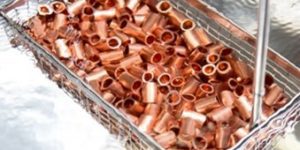Speed Saves at Riviera Tool Company
Riviera Tool Company speeds SLAB Milling up to 40 percent.
Posted: February 7, 2008
In most die and mold shops, one of the biggest single chunks of machining time goes to slab milling, so speeding that operation exerts a lot of positive leverage on profitability and competitiveness.
Just ask Riviera Tool Company (Grand Rapids, MI), a very progressive die and mold shop that runs 24/6, serving the automotive and truck-body market. Over the past year, the company has switched over to tangential milling for the rough and finish slabbing work, and raised throughput more than 40 percent. Tool life rose as well, while power consumption dropped.
Riviera does the slab milling with an assortment of Ingersoll tangential milling cutters 4 in, 6 in, 8 in, 12 in and the new 1 in diameter cutters, the smallest tangential milling cutter available.
Saving 20 Hours on Every Shoe
“Every time I slab a die shoe now and we do several of them daily — I save 20 hours,” says Frank Upton, Riviera machine manager. “Tool life is up as well, and power consumption is down. The power meter that used to read 95% of machine capacity or higher now hovers nearer 80%. We gradually standardized on tangential milling for flat slabbing work only since early, but I know we’ve already saved more than $100,000 in machining time, and I’m sure the power reduction will also help our machines last years longer.”
Riviera represents one of the first applications of the new 1-inch Ingersoll S-MAX Micro tangential milling (TM) cutter, which brings the proven benefits of tangential milling to smaller work.
Inserts Lie Flat for Stronger Presentation
In tangential milling, the inserts are oriented differently. They lie flat around the cutter's pitch line rather than standing up radially, as in conventional cutters (fig 1). This tangential orientation presents the insert’s strongest cross section to the main cutting force so that the inserts last longer.
The result has always been much longer edge life. Ingersoll introduced the tangential milling concept back in the ?60s, and has led its expansion ever since. The main original role for the tangential milling process was to improve tool life on big jobs like hogging wide-area flats on large automotive castings and steel parts.
Now with freer cutting insert geometries and smaller cutter diameters, tangential milling is emerging as a solution for faster removal with lower cutting forces. The wider size range of cutters also makes it a good option on small slots and cavity work as well as large-area slabbing. The only must is that the bottom of the cut be flat. “Today’s tangential milling may be a lot of good things to a lot more people, even on low HP machines,” says Ingersoll’s Scott Tilton, “but its Z-axis contouring capabilities are limited.”
Test Shows a Better Way
Riviera’s conversion to tangential milling began with a suggestion, and a test, in early ’06. Upton was looking for a way to speed up one of their bedrock operations and eliminate too-frequent tool failures, and asked Ingersoll’s Chad Meyer for suggestions. Their main obstacle to faster milling with the old tool was tool rupture, not gradual wear. “The inserts simply broke off, leaving a stump,” said Upton. He was also concerned about and the high power consumption that could burn out a motor or stall the machines. “Sometimes the needle on the power meter pegged,” he added.














